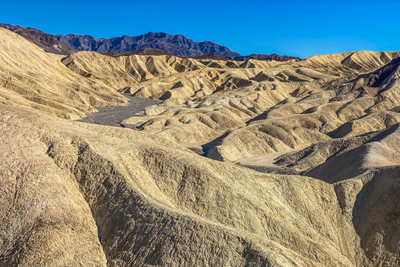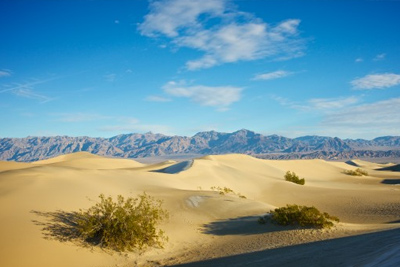Discover Death Valley
Along the California and Nevada border lies an extraordinary national park called Death Valley. Death Valley, also known as
the "land of extremes," is famous for being the hottest, driest, and lowest national park in the United States. However,
Death Valley is more than just a desert plain; it offers visitors various landscapes to explore, including snow, meadows,
and more!
The closest major city to Death Valley is Las Vegas, Nevada. The distance from Las Vegas to Death Valley is about 130 miles.
Death Valley is an approximate 2-hour drive or 1-hour helicopter charter away from Las Vegas, making it the perfect day trip
for those looking to temporarily escape all the glitz and glamor of the big city.
History
In 1993, Death Valley National Park was deemed a national monument. The Civilian Conservation Corps kickstarted the overall
development of Death Valley. For the next nine years, multiple groups of the Civilian Conservation Corps worked to establish
the region by constructing buildings, trails, and camps. Phone and water services were later introduced to the area as well.
In addition to its breathtaking landscape, Death Valley also served as a thriving mining mecca. Gold, silver, copper, tungsten,
lead, zinc, antimony, and borax were mined extensively throughout the valley. However, the last known mining operation was the
"Billie Mine," which closed in 2005.
Things to Do
There are countless bucket-list activities to accomplish when visiting Death Valley. Some top things to do when visiting Death
Valley include sightseeing, hiking, backcountry driving, and a helicopter charter!
Sightseeing
There is much to see across Death Valley National Park's 3.4 million-acre landscape! Some popular sightseeing locations include
Artists Palette, Zabriskie Point, and Badwater Basin.
- Artist's Palette - Behind the uniform
yellow landscape of this national park is a hidden array of colorful hills. These hills contain breathtaking hues of red,
orange, yellow, blue, pink, and green. The Artist's Palette gets its stunning shades from volcanic deposits rich in compounds
such as iron oxides and chlorite, creating its iconic rainbow effect.
- Zabriskie Point - Zabriskie
Point is a beautiful vista of badlands near Furnace Creek. From Zabriskie Point, experience unobstructed views of vibrant
badlands, multicolored mountains, and more from Manly Beacon, Red Cathedral, Artist’s Palette, Gower Gulch, and more!
- Badwater Basin - Badwater Basin, an expansive
salt flat, is the lowest point in North America at 282 ft below sea level. The salt flat covers approximately 200 square
miles and contains sodium chloride, calcite, gypsum, and borax. An epic site to see, Badwater Basin contains unique
geometric salt polygons resulting from groundwater rising up through the deposits and evaporating.

Hiking
Hiking is a popular activity for travelers visiting Death Valley National Park. Visitors are encouraged to hike from November
through March, as the summer temperatures can be dangerous. However, it is recommended that visitors save the low-elevation
hikes for the cooler winter days as it snows and high-peak hikes for the warmer months to escape the heat.
- Darwin Falls - Hidden within a seemingly uniform
desert landscape lies an epic water oasis. Darwin Falls is a waterfall located on the outskirts of Death Valley National
Park, near the settlement of Panamint Springs, California. Completing a hike to Darwin Falls is an absolute must and is
ideal for beginner and intermediate hikers. The walk is approximately 2.1 miles, and the route is easy to follow!
- Mosaic Canyon - Another popular
hike at Death Valley National Park is the Mosaic Canyon Trail. This trail is located south of Stovepipe Wells, California,
and is approximately 3.6 miles in total. The unique thing about this hike is that you will witness tiny angular fragments
made up of various rocks embedded within the natural cement along the way.
- Telescope Peak - If you are an
experienced hiker and up for the challenge, Telescope Peak Trail is for you! Located 34.9 miles southeast of Panamint
Spring, California, is Telescope Peak, the highest point within Death Valley National Park. At 11,049 feet above sea level,
Telescope Peak Trail will push you to your limit but reward you with the most stunning panoramic views of Death Valley
National Park. This hike is about 11.7 miles and takes approximately 7 hours to complete.

Back Country Driving
If you want an adrenaline-pumping activity, consider
backcountry driving through Death Valley National Park. In fact, Death Valley contains more miles of
roads than any other national park! Approximately 1,000 miles of paved and dirt roads are designated for visitor recreation.
- Titus Canyon - Titus Canyon is the
most popular back country road in Death Valley National Park. Its starting point begins at Nevada Highway 374, 2 miles east
of Park Boundary Road, and is approximately 27 miles long. This road takes you through the windy Grapevine Mountains, a
ghost town, petroglyphs at Klare Spring, and canyon narrows.
- Echo Canyon - Echo Canyon, located in the
central part of Death Valley National Park and two hours northwest of Las Vegas, is another ideal location for backcountry
driving. Echo Canyon Road is a two-track gravel road with a firm base. This road takes you through Needle's Eye Arch, Lee's
Camp Road, and the Inyo Mine Camp. Echo Canyon Road passes through narrow terrain, climbs over mountains, and ends on the
edge of the Death Valley Wilderness Area.
Helicopter Charters
If you are looking for an efficient and exhilarating way to get from Las Vegas to Death Valley National Park, consider a luxury
helicopter charter! A helicopter charter from Las Vegas to Death Valley is approximately 1 hour
and 10 minutes one-way.
The benefits of a helicopter charter from Las Vegas to Death Valley include the following:
- A memorable experience for up to 7 guests per aircraft
- Convenient departure and landing locations
- Unparalleled bird's-eye views between Las Vegas and Death Valley
- Minimizing travel time between Las Vegas and Death Valley
As you can see, there is a wide range of areas to see and explore within Death Valley National Park. We hope that you found this
information helpful and that some, if not all, of these activities, make it to your Death Valley National Park bucket list!